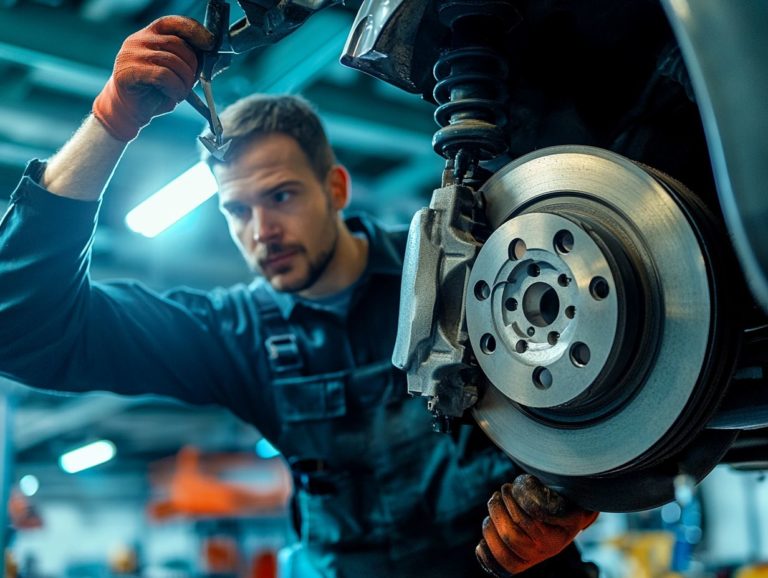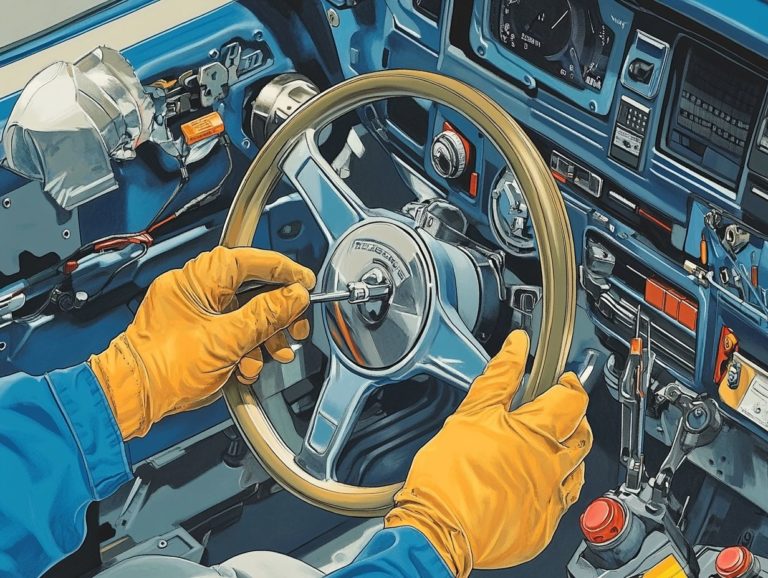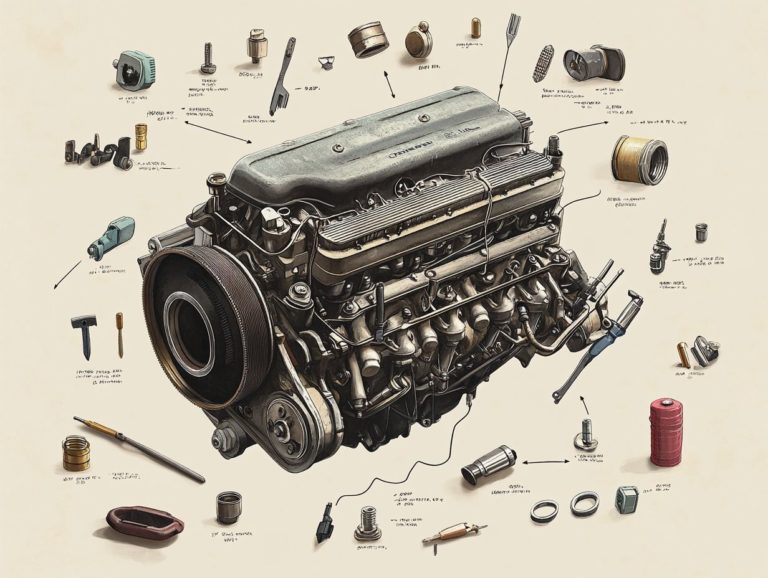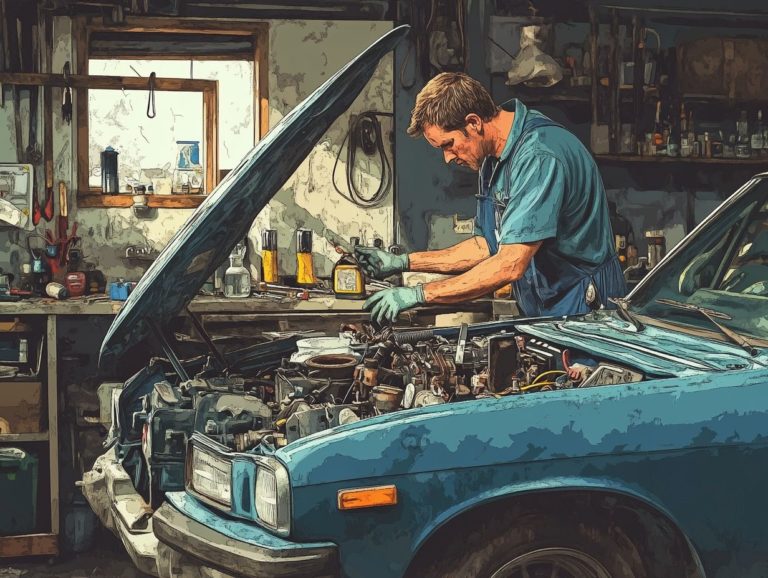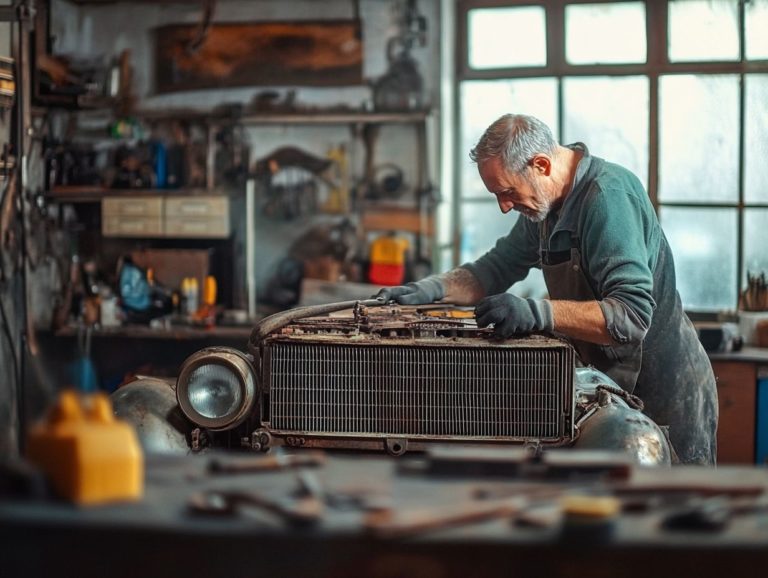What to Do When Your Car Won’t Start
When your car refuses to start, your day can quickly spiral out of control. Identifying common causes like a dead battery or ignition issues is your first step to getting back on the road.
This guide provides essential troubleshooting steps to help you pinpoint the issue, strategies for what to do if you can’t resolve it, and preventive measures to ensure your vehicle runs smoothly.
Whether you re a seasoned driver or just starting out, this information will empower you to navigate the frustrating experience of a car that simply won t start.
Contents
- Key Takeaways:
- Common Reasons for a Car Not Starting
- Facing Starting Issues with Your Car?
- Troubleshooting Steps
- What to Do if You Can’t Fix the Issue
- Preventive Measures to Avoid Future Problems
- Frequently Asked Questions
- What to Do When Your Car Won’t Start?
- What are the common causes of a car not starting?
- What should I do if my car won’t start due to a dead battery?
- Why does my car make a clicking noise but won’t start?
- What do I do if my car won’t start after filling up with gas?
- What should I do if my car won’t start due to electrical issues?
Key Takeaways:
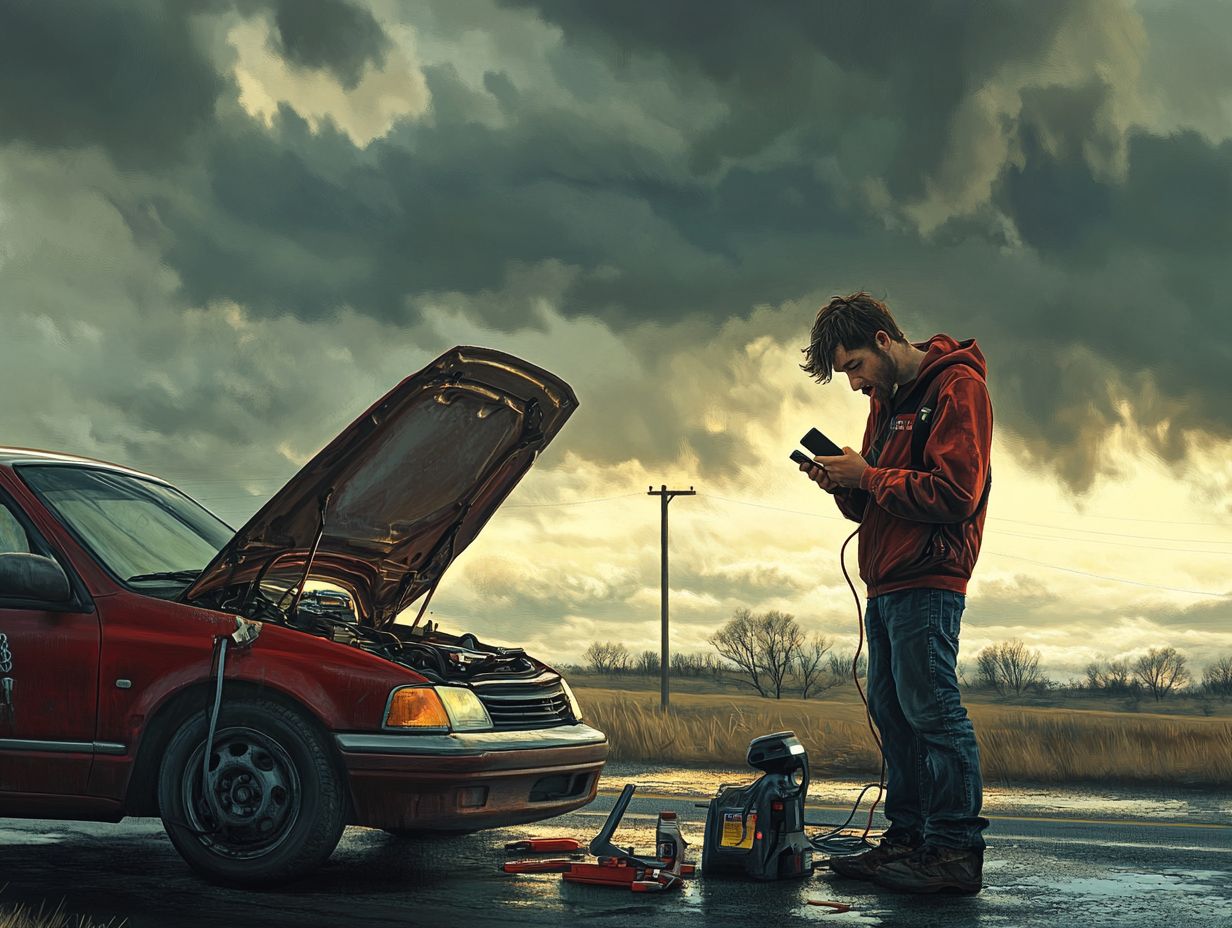
- Always check the battery first when your car won’t start. A dead battery is the most common reason for a car not starting.
- If the battery is not the issue, troubleshoot the ignition system and fuel system. These are the next most common causes.
- If you cannot fix the issue, call for roadside assistance or tow your car to a mechanic.
Common Reasons for a Car Not Starting
It s frustrating when your car won’t start, especially in cold places like Michigan or Wisconsin. Knowing the common reasons for this problem can save you time and money.
Some of the most frequent causes include:
- a dead battery
- a malfunctioning alternator
- a faulty starter
- issues with the ignition switch or fuel pump
This article will delve into these factors in detail, along with essential troubleshooting steps to help you diagnose and resolve the issue effectively.
Dead Battery
A dead battery is often the main culprit behind a car that refuses to start, typically stemming from poor connections or corroded terminals that disrupt the electrical system s functionality.
Recognizing the signs of a dead battery is essential for any vehicle owner. Symptoms such as dim headlights, slow engine cranking, or the complete absence of dashboard lights can signal that your battery has lost its charge.
To confirm your suspicions, conduct a quick inspection of the battery cables, ensuring they re securely connected and free of corrosion.
Stuck with a car that won’t start? A jump-start might just be the quick fix you need!
- Connect jumper cables to a functioning vehicle’s battery.
- Carefully match the positive and negative terminals.
- Allow the current to flow.
Watch the connections for any signs of deterioration, as corroded terminals can significantly impede the jump-start process.
Ignition Issues
Ignition issues, especially involving the ignition switch or a faulty starter, are often the sneaky causes that keep your engine from cranking properly when you turn the key or press the key fob.
Knowing how these parts work together helps you diagnose the issue more easily. The ignition switch is pivotal in powering up your electrical system, enabling current to flow to the starter. If this switch fails, you might find the key fob completely unresponsive, leaving you in a frustrating situation.
Conversely, a faulty starter may produce an annoying clicking sound or completely fail to engage the engine crank. To troubleshoot these issues, begin by checking the battery voltage and connections after all, a weak battery can complicate matters significantly. If everything seems to be in order, inspect the ignition switch and starter for any signs of wear or malfunction, ensuring a smoother starting process for your vehicle.
Facing Starting Issues with Your Car?
Discover how to troubleshoot common problems effectively!
Fuel System Problems
Problems within your fuel system, such as a malfunctioning fuel pump or a clogged fuel filter, can cause annoying issues where your vehicle struggles to start or simply fails to turn over altogether.
The fuel system plays a vital role in delivering the necessary fuel from the tank to the engine, ensuring your vehicle operates at its best. If the fuel pump isn t functioning correctly, it may not deliver adequate pressure, resulting in rough starts or hesitation when you accelerate. A clogged fuel filter can block the flow of fuel, making it difficult for your engine to pull in what it needs.
You might notice symptoms like unusual noises emanating from the fuel tank, a decrease in power, or even unexpected engine stalling annoyances that can leave any driver feeling exasperated.
Troubleshooting Steps
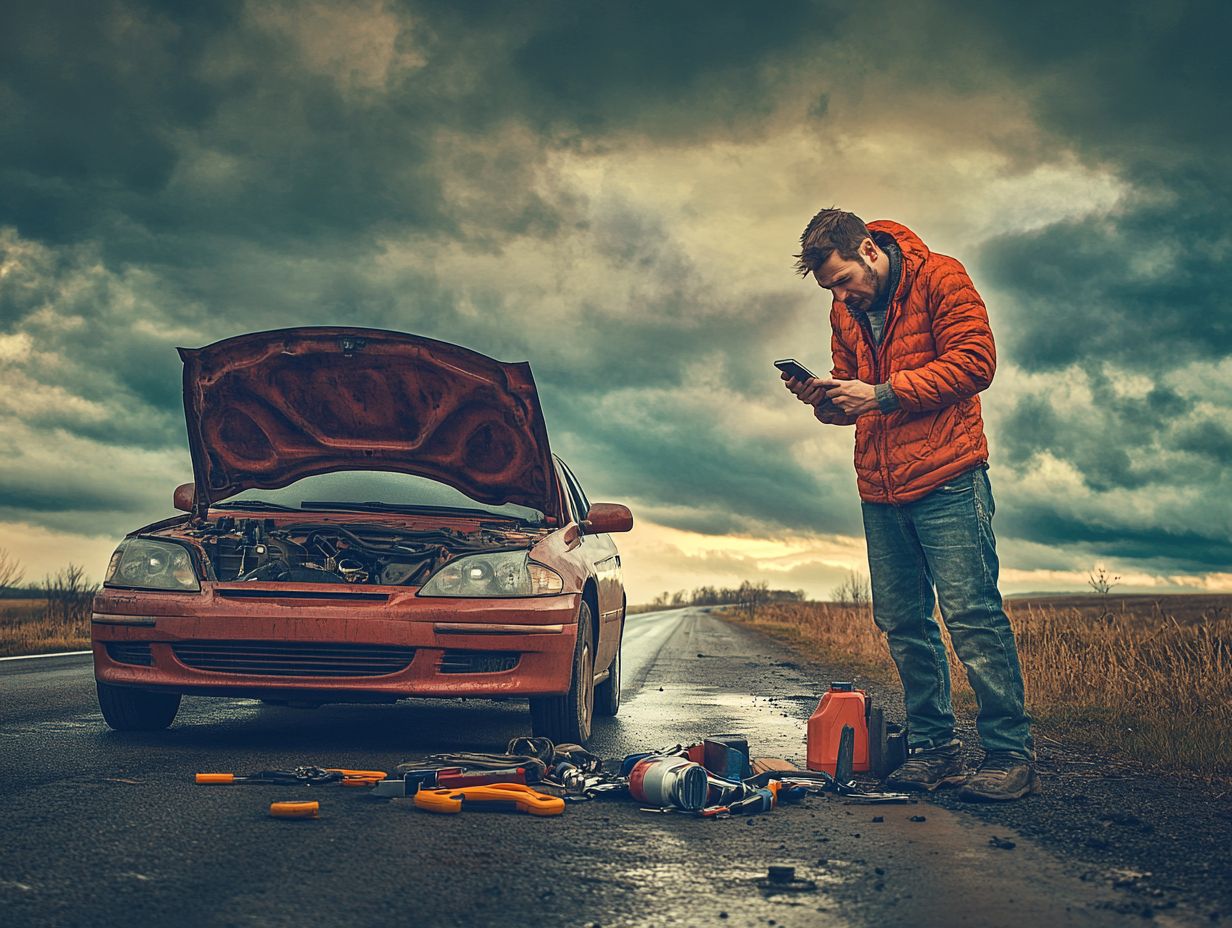
If your car won’t start, act quickly! A step-by-step method can save you time and money. Begin by checking the battery, as a weak or dead battery is often the culprit. For more detailed guidance, refer to our article on what to do when your car won’t start.
Next, test the ignition system to ensure everything is functioning properly. Don t forget to examine the fuel system, as issues here can also prevent your car from starting.
By following these steps, you can potentially avoid costly repairs at a mechanic shop or the inconvenience of needing roadside assistance.
Checking the Battery
Checking the battery is the essential first step in troubleshooting, especially in cold weather when battery performance can take a nosedive and lead to a dead battery or complications with terminals and cables.
- Start with a thorough inspection by visually examining the battery for any signs of corrosion or damage around the terminals and cables, as these issues can block proper connections.
- Once you’ve completed this visual check, grab a multimeter to test the voltage. A fully charged battery should ideally read around 12.6 volts or more; however, during colder conditions, you might notice a drop in voltage, which can significantly affect performance.
It s vital to keep an eye on these readings, as lower voltages can signal a weak charge or impending battery failure. This is especially important during the chillier months when your battery is under increased demands.
Testing the Ignition System
Testing the ignition system is essential, as faults in the ignition switch or a malfunctioning starter can leave you stranded without a reliable engine crank.
To ensure the system is in prime condition, start by inspecting the ignition switch for any signs of wear or damage. Turn the key and listen for clicks or the absence of any electrical response can often reveal important clues.
Next, checking the starter is a must. You may notice unusual noises or, in some cases, complete silence when you attempt to start your vehicle. Using a multimeter to assess the voltage at the starter terminals will help confirm whether the starter is receiving adequate power.
These diagnostic steps are crucial for identifying issues that could escalate into more significant problems down the line.
Examining the Fuel System
When your car won t start, examining the fuel system becomes essential. Issues with the fuel pump, clogged fuel lines, or a malfunctioning fuel filter can severely hinder performance.
Understanding how each component operates allows you to pinpoint the problem more effectively. For instance, if the engine cranks but doesn t catch, it could indicate an inadequate fuel supply. Symptoms like sputtering or stalling during acceleration often point to a dirty fuel filter or failing fuel injectors.
To accurately diagnose the fuel system, consider employing these methods:
- Measure fuel pressure with a gauge
- Inspect the fuel pump fuse
- Visually examine the lines for leaks
Engaging in these diagnostic strategies ensures a thorough assessment, ultimately leading to a smoother repair process.
What to Do if You Can’t Fix the Issue
If you can’t fix the starting problem, don’t hesitate to call for roadside assistance or have your car towed to a trusted mechanic. This ensures that your car is repaired safely and efficiently, giving you peace of mind in the process.
Calling for Roadside Assistance
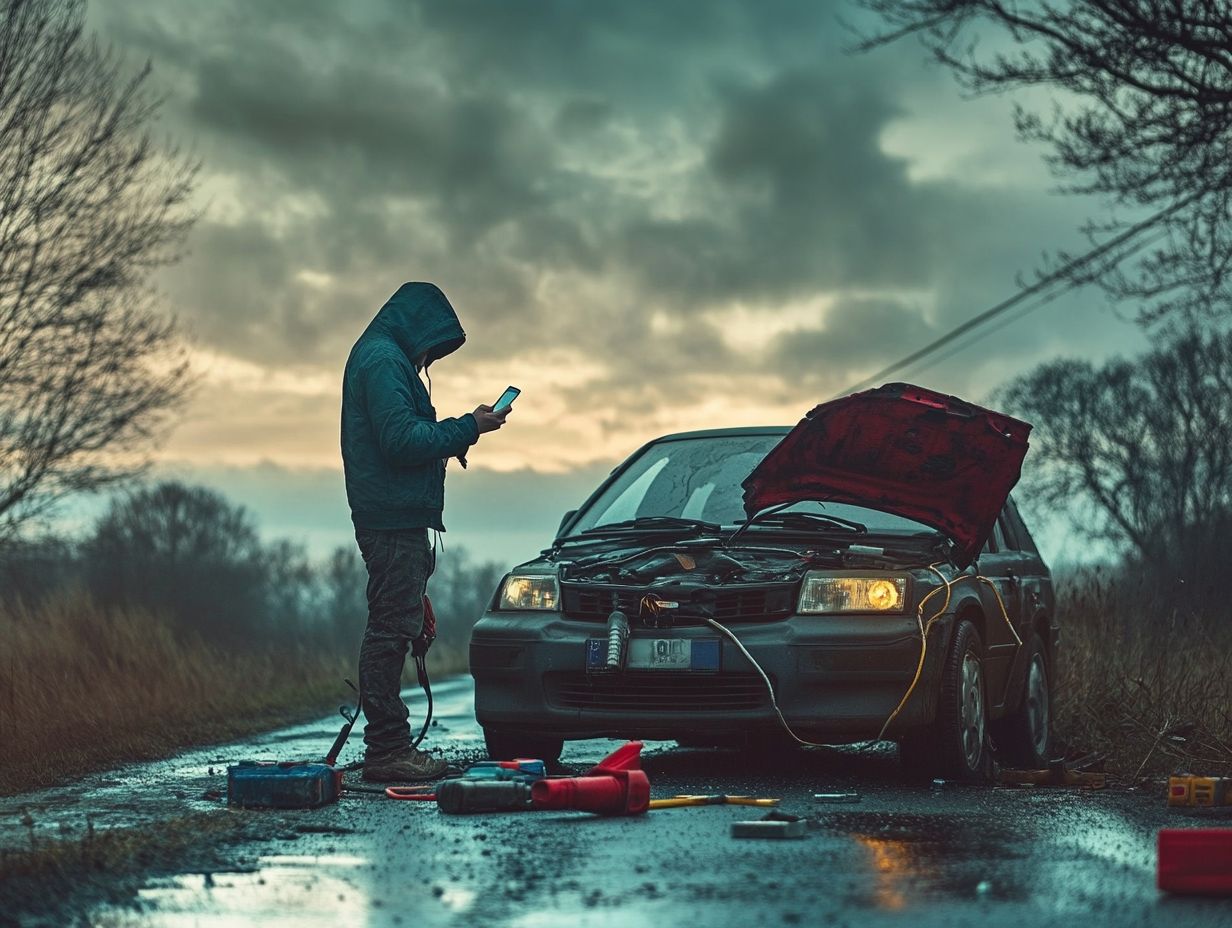
When your car won t start, calling for roadside assistance can be your lifeline. This service will guide you to a dependable towing service or mechanic for further diagnostics.
Start with a quick phone call to the service provider. Share essential details like your location, the make and model of your car, and a brief description of the issue.
Clear communication is key to ensuring the right type of assistance is dispatched. Depending on your service plan, costs may vary. Some providers may cover the fee, while others might require upfront payment for towing or repairs.
Be prepared to discuss any membership benefits you have. These can greatly influence the overall cost and contribute to a smoother experience, ensuring help arrives promptly.
Getting Your Car Towed
If your car won t start, getting it towed might be necessary. A reliable towing service will safely transport your car to a trusted mechanic.
Choosing the right towing service is essential; it sets the tone for a smooth experience. Research local towing companies, check their reviews, and inquire about their services.
Once you make your selection, expect clear communication about estimated arrival times and any potential costs involved. The towing team should secure your car properly to prevent damage during transport.
Upon arrival at the mechanic shop, the towing professionals will assist you in unloading. This makes it easier to kickstart the repairs necessary to get your car back on the road.
Preventive Measures to Avoid Future Problems
Implementing preventive measures like regular maintenance and inspections can greatly reduce the chances of your car refusing to start. This enhances reliability and provides peace of mind while navigating the open road.
Regular Maintenance and Inspections
Regularly checking your car’s battery, electrical system, and fuel system is essential for preventing starting issues. This will help extend your car’s lifespan.
Ensure that battery connections are tight and free from corrosion, as loose or dirty connections can hinder performance. Inspect the electrical system for frayed wires or blown fuses, as these can disrupt power flow.
Examine the fuel system components, like fuel filters and injectors, to ensure efficient fuel delivery. By consistently addressing these areas, you can avoid unexpected breakdowns and enhance your car’s overall reliability.
Keeping Emergency Supplies in Your Car
Keeping emergency supplies in your car, like jumper cables, a safety hammer, and a portable battery charger, offers peace of mind and helps tackle minor issues quickly.
Having a well-stocked emergency kit isn t just about being prepared for the unexpected; it enhances safety for everyone on the road with you. Essentials like a first-aid kit, flashlight, and road flares are vital for addressing injuries or signaling for help during roadside emergencies.
A multi-tool can prove invaluable for various tasks, ensuring you’re ready for anything that comes your way. By making sure these crucial supplies are easily accessible, you can reduce stress during unforeseen events and promote overall safety.
Frequently Asked Questions

What to Do When Your Car Won’t Start?
If your car won’t start, remain calm and troubleshoot the issue. Here are some steps you can take, including what to do when your car won’t start, to determine the cause and get your car running again:
- Check the battery connections.
- Inspect the electrical system for any issues.
- Look for signs of fuel delivery problems.
What are the common causes of a car not starting?
Your car may not start for many reasons. Common causes include a dead battery, a faulty starter, fuel pump issues, electrical problems, and a clogged fuel filter.
Understanding these causes can save you time and money!
What should I do if my car won’t start due to a dead battery?
If you think a dead battery is the issue, try jump-starting it with another vehicle.
If that fails, replace the battery. Regular battery checks can help prevent future problems.
Why does my car make a clicking noise but won’t start?
A clicking noise when you turn the key might mean a faulty starter.
This sound indicates power to the starter, but it s not engaging correctly. In this case, you may need a starter replacement.
What do I do if my car won’t start after filling up with gas?
If your car won’t start after getting gas, the fuel filter might be clogged.
The fuel filter cleans the fuel, and when it s blocked, it can stop fuel from reaching the engine. Check your fuel filter today to keep your engine running smoothly!
What should I do if my car won’t start due to electrical issues?
If you suspect electrical issues, seek professional help.
Electrical problems can be tricky to diagnose and fix. A trained mechanic can help you avoid further damage to your car.


